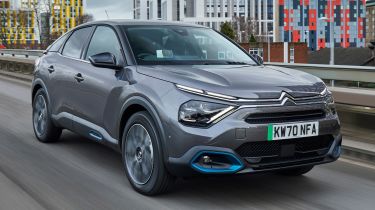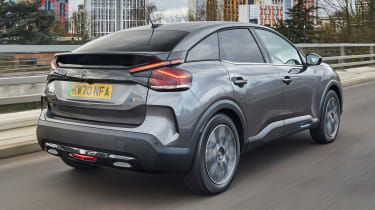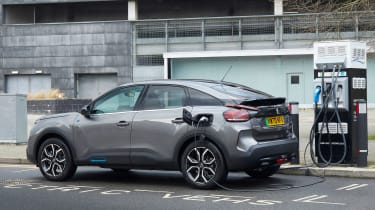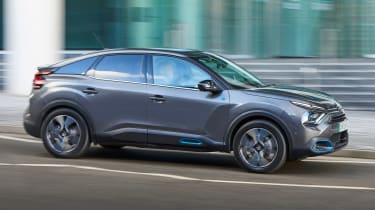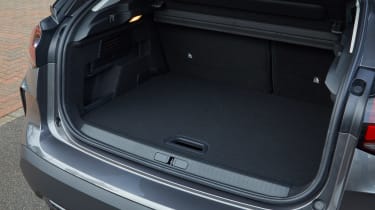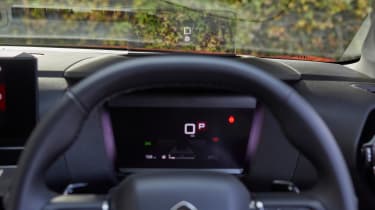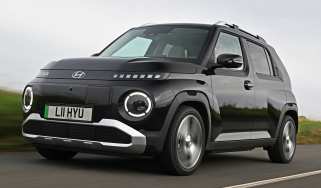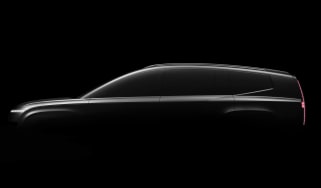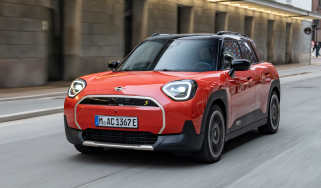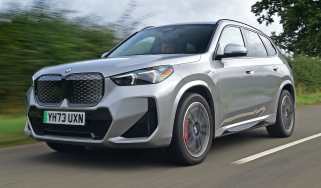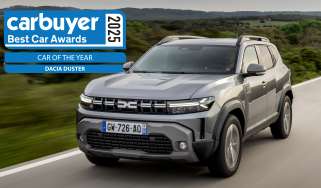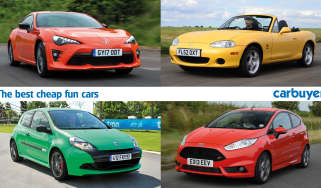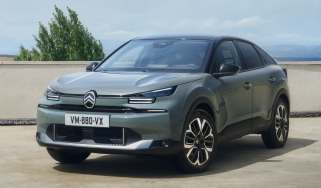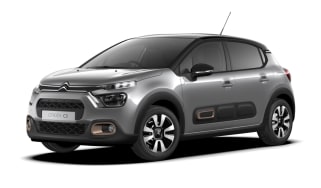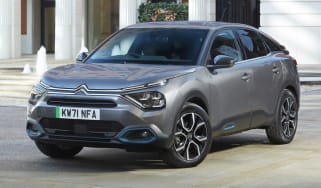Citroen e-C4 hatchback review
"The Citroen e-C4 hatchback is a stylish electric car that's safe, practical and comfortable"
Pros
- Comfortable
- Cheap to run
- 100kW charging
Cons
- Sluggish performance
- Mediocre range for 50kWh version
- Older battery technology
Verdict - Is the Citroen e-C4 a good car?
The Citroen e-C4 is one of only a handful of genuinely affordable and good-value electric cars currently on sale. You’ll still pay quite a bit more than the equivalent petrol version, but if you can charge at home then the savings could be considerable. It’s good to drive, super comfy, and even pretty practical. The e-C4 is a great starter-EV, but even seasoned electric-car drivers could see merit in the French hatchback’s quirky personality.
Citroen e-C4 models, specs and alternatives
The Citroen e-C4 is the all-electric version of the French brand's latest family hatchback, designed to take on the Nissan Leaf and Volkswagen ID.3, and shares a number of parts (and its platform) with the Peugeot e-2008 and recently-updated DS 3 E-Tense. The e-C4’s rugged look is intended to appeal if you’re also considering cars like the Hyundai Kona Electric and Mazda MX-30, and with prices starting at just over £30,000, the e-C4 is affordable for a car in its class.
It's certainly no rebadging exercise because the e-C4 has a shape, size and identity all of its own. Citroen has chosen to step away from the old C4's forgettable design, instead taking inspiration from SUVs to make it far more fashionable.
A plunging coupe-style roof means its tough looks don't add up to lots of extra interior space but there's decent head and knee room for four adults and their luggage. Speaking of which, the 380-litre boot is only a few litres smaller than the ID.3's and exactly the same size as the petrol and diesel C4, which is impressive for an EV with a large battery under the floor. If boot space is a top priority, Citroen also offers the e-C4 X – though beware, the saloon-style opening does compromise outright practicality.
More reviews
An update to the e-C4 lineup in May 2023 brought a higher-capacity 54kWh battery and more efficient 154bhp electric motor as used in the Vauxhall Astra Electric and Peugeot e-308. Despite an increase in capacity, the 54kWh battery pack is physically smaller than the older 50kWh battery and therefore keeps weight down, helping to increase range from an official 222 miles to up to around 260 miles on a charge. Models with the 50kWh battery and 134bhp motor continue to be offered alongside the updated models.
The e-C4 will charge at up to 100kW, which is largely competitive in this area of the market, and results in a 10-80% charge in around half an hour using a suitably fast rapid charger.
The e-C4 isn’t the fastest car in its class, but plentiful torque reserves mean it feels nippy around town. The 0-62mph sprint in the 134bhp version takes exactly 10 seconds, while top speed – not that it really matters – is limited to 93mph.
There is a bit more choice when it comes to trim, with four specs currently offered: Sense, C-Series Edition, Shine Plus and e-Series – the mid-range Sense Plus is only offered on the petrol and diesel-powered C4. All e-C4s come with LED lights, 18-inch wheels and a 10-inch touchscreen, plus Citroen’s hydraulic Advanced Comfort Suspension system.
Flagship models cost around £3,000 more but add assisted driving functions and extra safety features, plus Alcantara seats and other luxuries, while the e-C4 e-Series (new for June 2023) gets darker trim, plus black wheels and a black roof. Some might consider it the sportier-looking sibling.
Range, charging & running costs
The Citroen e-C4 is more expensive to buy than a petrol or diesel version but the cost savings begin as soon as you arrive home from the showroom. Providing you’re signed up to an off-peak energy tariff, recharging the battery from a wallbox should only cost a few pounds – rather than around £50 to fill a fuel tank. The e-C4 can travel for up to 222 miles for the 50kWh battery option, or 260 for cars with the 54kWh battery in ideal conditions (the slightly slipperier e-C4 X will do a couple of miles more) which is a little shy of rivals like the Volkswagen ID.3 58kWh (265 miles) or Kia Niro EV’s 288 miles.
Charging speeds are competitive. The Citroen’s 100kW peak beats the Kia’s 80kW maximum charging speed, and should be able to go from 10-80% in around 30 minutes. Charging the battery will take around 7.5 hours using a 7kW wallbox; an 11kW on-board charger is optional – but beware, as your home or place of work will need three-phase electrics to make use of this.
As with all zero-emissions cars, VED (road tax) is currently free for the e-C4, but it's business drivers who potentially stand to make the biggest savings. That's because Benefit-in-Kind liability for company-car drivers is based upon CO2 emissions, which are zero for the e-C4, cutting bills compared with petrol, diesel and even hybrid models. In fact, your annual payment could be less than £150 for the entire 2023/24 tax year.
Electric motor, drive & performance
The e-C4 comes with a choice of power outputs, the original 134bhp motor sending power to the front wheels, or from May 2023, an updated 154bhp motor shared with the Vauxhall Astra Electric and Peugeot. The 134bhp model gives it a 0-62mph time of 10 seconds, which is a bit slower than most rivals. With the updated 154bhp motor you can expect a 0-62mph time a full second faster than that of the old unit.
The e-C4 is perfectly fine around town, with a punchy response at low speeds. It’s only as you approach rural or motorway speeds that the Citroen seems to run out of puff. But this is a car that prioritises comfort over a sporty drive, so we’ve few complaints regarding outright performance.
That focus is summed up by Citroen’s Advanced Comfort Suspension, which is perfectly suited to UK roads – taking the edge off rough surfaces and giving the car a relaxed feel. It’s not perfect, however; this, added to the slightly taller body, means there is more lean in corners than you’ll find in a Volkswagen ID.3, plus the slower steering results in tardy reactions if you need to change direction quickly.
The e-C4 gets a 'B' mode that increases the amount of regenerative braking, so the driver can put more energy back into the battery and avoid using the brakes so much in town. It doesn’t offer one-pedal driving, but the system is intuitive enough to use.
Interior & comfort
Interior quality has taken a step up from the old C4, and technology like a standard 10-inch infotainment screen and digital instrument display help the Citroen feel modern and slick. It’s worth noting, however, that updates in early 2023 saw higher-spec C-Series Edition and Shine Plus models fitted with the HD screen tech from the bigger C5 X. Sense cars make do with the older setup – and no in-built navigation. All cars get Apple CarPlay and Android Auto, though.
Speaking of the infotainment system, while it’s hardly the most cutting-edge – look towards Kia and Hyundai for that – it’s more responsive than Volkswagen’s current offering. The HD screen in higher-spec e-C4s also brings better resolution for the parking cameras, which is a welcome upgrade.
Elsewhere, there are plenty of neat touches dotted around the interior, like the practical centre console, places to keep your smartphone, and the novel tablet holder for the front passenger. We're also glad there are attractive and logical dials for the climate control, so you don’t need to dive into the touchscreen just to adjust the temperature; another area where the Citroen triumphs over the VW.
Every e-C4 is fitted with Citroen's Advanced Comfort suspension, which is designed to better absorb impacts from severe bumps and potholes. It works pretty well, with only the deepest craters sending a shudder through to passengers. The extra weight of the battery pack seems to work in the car's favour here because the e-C4 feels more settled than the petrol version.
As of mid-2023, there are four trim levels to choose from: Sense, C-Series Edition, Shine Plus and e-Series. Even the entry-level version (priced from just under £31,000) is fitted with 18-inch wheels, dual-zone climate control and rear parking sensors. The now-discontinued Shine Edition was introduced in early 2022, and added sat nav (with live traffic updates), a head-up display, adaptive cruise control, all-round parking sensors, a rear-view camera and a heated steering wheel. Most of this kit can now be found on the mid-spec C-Series Edition.
The Shine Plus version brings wireless smartphone charging, an upgraded set of speakers, heated front seats and half-leather upholstery. These cars cost around £35,000, while for around £1,300 more you can upgrade to the e-Series spec, which swaps out some of the standard trim for dark chrome, and adds black wheels and a black roof. This version certainly looks the part, but its value is subjective.
Citroen is yet to reveal pricing for the larger 54kWh battery, so we're not able to comment on whether it's worth the extra. The complete removal of the Government’s Plug-in Car Grant (PiCG) in 2022 means there are no official incentives to be had on the e-C4 range.
Practicality & boot space
While you don't sit quite as high in the e-C4 as you do in a regular SUV, the driving position is slightly more commanding than in the Volkswagen ID.3. Citroen has also prioritised seat comfort, so the e-C4 should be good for longer trips – even if the range doesn’t quite lend itself to motorway driving.
Space up front is adequate for tall adults, while rear headroom may appear limited by the sloping roof but isn't actually too bad. Proper rear doors and more knee room make it better for rear passengers than the Mazda MX-30, too.
There's 380 litres of space in the e-C4's boot, which matches the Volkswagen Golf and is just five litres off the ID.3. It also matches the petrol and diesel versions of the C4, which is possible because the platform was intended for use as the basis of electric models from the off. One small gripe is the quirky rear spoiler, which may reduce drag but also cuts rear visibility by covering the bottom of the rear window.
Reliability & safety
While we can't comment on the e-C4's reliability yet, Citroen itself is climbing the ranks in our annual Driver Power owner satisfaction survey. The brand jumped from 27th to 13th out of 29 car makers in the 2022 rundown – but it’ll need to focus if it wants to avoid yo-yoing back towards the bottom next year.
Owners seemed happy with their cars’ fuel economy – an e-C4 strong point – and servicing costs. Practicality was a plus point, too, as were Citroen’s scores for ride comfort and interior quality. The brand still has work to do on reliability though, where it finished in the bottom third of the table.
The e-C4 is fitted with a long list of safety equipment but that wasn’t enough to obtain a five-star Euro NCAP safety rating. While its adult and child protection scores were good, its 57% score for pedestrian protection let it down. Technology includes adaptive cruise control that can stop and then set off again in traffic, blind-spot detection and autonomous emergency braking.

